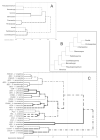Taxonomic Significance of Seed Morphology in Veronica L. (Plantaginaceae) Species from Central Europe
- PMID: 35009092
- PMCID: PMC8747532
- DOI: 10.3390/plants11010088
Taxonomic Significance of Seed Morphology in Veronica L. (Plantaginaceae) Species from Central Europe
Abstract
In this study, 1159 seeds of 29 Central European species of the genus Veronica were analyzed based on scanning electron microscopy images. The species belonged to nine subgenera: Beccabunga, Chamaedrys, Cochlidiosperma, Pellidosperma, Pentasepalae, Pocilla, Pseudolysimachium, Stenocarpon and Veronica, following the newest phylogenetic classification of the genus. Nine measured characteristics of seeds and nine ratios were analyzed statistically using ANOVA followed by post hoc testing, cluster analysis and discriminant analysis. In most cases, the results were not congruent with the contemporary classification of the genus. Examinations of qualitative seed features by scanning electron microscopy included the cochlidiospermous or discoid seed type, the seed shape, the general sculpture of the seed coat surface, the sculpture of anticlinal and periclinal walls and some species-specific traits such as the presence of the epidermal appendix. All these features, apart from seed shape, were useful to distinguish all subgenera and some species within subgenera: Beccabunga, Chamaedrys, Pellidosperma, Pocilla (only V. filiformis) and Veronica. The identification key based on the seed micromorphological features was prepared.
Keywords: micromorphology; numerical analysis; scanning electron microscopy; seed; seed coat.
Conflict of interest statement
The authors declare no conflict of interest.
Figures





References
-
- Albach D.C., Martínez-Ortega M.M., Fischer M.A., Chase M.W. A new classification of the tribe Veroniceae—Problems and a possible solution. Taxon. 2004;53:429–452. doi: 10.2307/4135620. - DOI
-
- Garnock-Jones P.J., Albach D.C., Briggs B.G. Botanical names in the Southern Hemisphere. Veronica (Plantaginaceae): Sect. Detzneria, sect. Hebe, and sect. Labiatoides. Taxon. 2007;56:571–582. doi: 10.1002/tax.562028. - DOI
-
- The Angiosperm Phylogeny Group. Chase M.W., Christenhusz M.J.M., Fay M.F., Byng J.W., Judd W.S., Soltis D.E., Mabberley D.J., Sennikov A.N., Soltis P.S., et al. An Update of the Angiosperm Phylogeny Group Classification for the Orders and Families of Flowering Plants: APG IV. Bot. J. Linn. Soc. 2016;181:1–20. doi: 10.1111/boj.12385. - DOI
-
- Plants of the World Online. [(accessed on 14 December 2021)]. Available online: https://powo.science.kew.org/taxon.
-
- Walters S.M., Webb D.A. Veronica L. In: Tutin T.G., Heywod V.H., Burges N.A., Moore D.M., Valentine D.H., Walters S.M., Webb D.A., editors. Flora Europaea. Volume 3. Cambridge University Press; Cambridge, UK: 1972. pp. 242–251. - DOI
Grants and funding
LinkOut - more resources
Full Text Sources

